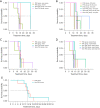Real-world effectiveness of azvudine for patients infected with the SARS-CoV-2 omicron subvariant BA.5 in an intensive care unit
- PMID: 37868850
- PMCID: PMC10586978
- DOI: 10.21037/jtd-23-1093
Real-world effectiveness of azvudine for patients infected with the SARS-CoV-2 omicron subvariant BA.5 in an intensive care unit
Abstract
Background: Azvudine (FNC) has been shown to be effective against severe acute respiratory syndrome coronavirus 2 (SARS-CoV-2), but data regarding the Omicron BA.5.1.3 subvariant are lacking. This retrospective analysis investigated the effectiveness and safety of FNC against the SARS-CoV-2 Omicron BA.5.1.3 subvariant in a real-world setting, utilizing data from a patient cohort at our institution.
Methods: Data were retrospectively collected from patients admitted to the intensive care unit (ICU) of Sanya Central Hospital during the Sanya outbreak (August 13 to September 7, 2022). The patients, all infected with the Omicron BA.5.1.3 subvariant, were selected based on predefined inclusion and exclusion criteria. The patients were classified as the FNC (azvudine 5 mg, qd + standard supportive treatment) and non-FNC (standard supportive treatment only) groups.
Results: The study comprised 13 patients, with 6 and 7 in the FNC and non-FNC groups, respectively. Baseline data, clinical features, and imaging manifestations were generally similar between the two groups. However, patients administered FNC demonstrated significantly lower levels of inflammatory indicators at baseline. Although there was no significant difference in the duration of ICU stay between the FNC and non-FNC groups, overall ICU stay appeared to be reduced in the FNC group.
Conclusions: FNC emerges as a feasible treatment against the Omicron BA.5.1.3 subvariant. It may reduce ICU stay and demonstrate a promising safety profile without major side effects or disruption to normal physiological parameters.
Keywords: Azvudine; intensive care unit (ICU); severe acute respiratory syndrome coronavirus 2 omicron subvariant BA.5 (SARS-CoV-2 omicron subvariant BA.5).
2023 Journal of Thoracic Disease. All rights reserved.
Conflict of interest statement
Conflicts of Interest: All authors have completed the ICMJE uniform disclosure form (available at https://jtd.amegroups.com/article/view/10.21037/jtd-23-1093/coif). The authors have no conflicts of interest to declare.
Figures




Similar articles
-
Characteristics of patients with non-severe infections of different SARS-CoV-2 omicron subvariants in China.Front Med (Lausanne). 2024 Dec 18;11:1511227. doi: 10.3389/fmed.2024.1511227. eCollection 2024. Front Med (Lausanne). 2024. PMID: 39744529 Free PMC article.
-
Effectiveness of azvudine against severe outcomes among hospitalized COVID-19 patients in Xinjiang, China: a single-center, retrospective, matched cohort study.Expert Rev Anti Infect Ther. 2024 Jul;22(7):569-577. doi: 10.1080/14787210.2024.2362900. Epub 2024 Jun 27. Expert Rev Anti Infect Ther. 2024. PMID: 38822541
-
Estimates of SARS-CoV-2 Omicron BA.2 Subvariant Severity in New England.JAMA Netw Open. 2022 Oct 3;5(10):e2238354. doi: 10.1001/jamanetworkopen.2022.38354. JAMA Netw Open. 2022. PMID: 36282501 Free PMC article.
-
Clinical Efficacy of the Neutralizing Antibody Therapy Sotrovimab in Patients with SARS-CoV-2 Omicron BA.1 and BA.2 Subvariant Infections.Viruses. 2023 May 31;15(6):1300. doi: 10.3390/v15061300. Viruses. 2023. PMID: 37376600 Free PMC article.
-
Viral sepsis-induced mortality of older patients infected by the Omicron subvariant BA.5 of SARS-CoV-2: a retrospective study.BMC Infect Dis. 2025 Apr 22;25(1):577. doi: 10.1186/s12879-025-10894-7. BMC Infect Dis. 2025. PMID: 40264006 Free PMC article.
Cited by
-
Effectiveness and safety of azvudine in COVID-19: A systematic review and meta-analysis.PLoS One. 2024 Jun 13;19(6):e0298772. doi: 10.1371/journal.pone.0298772. eCollection 2024. PLoS One. 2024. PMID: 38870134 Free PMC article.
-
Systematic evaluation of therapeutic effectiveness of Azvudine in treating COVID-19 hospitalized patients: a retrospective cohort study.Front Cell Infect Microbiol. 2024 Nov 7;14:1453234. doi: 10.3389/fcimb.2024.1453234. eCollection 2024. Front Cell Infect Microbiol. 2024. PMID: 39575306 Free PMC article.
References
LinkOut - more resources
Full Text Sources
Miscellaneous
